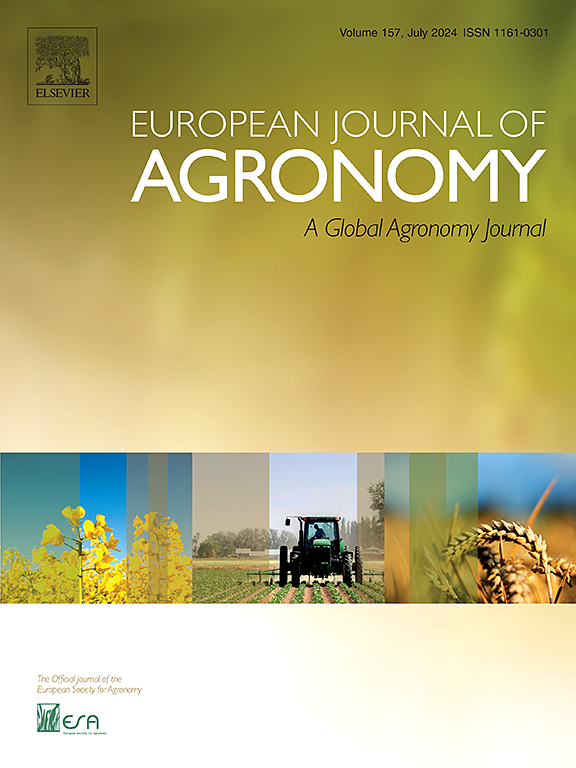Sentinel-2图像能否支持以玉米为主的小农农业系统中豆科作物田的识别?
IF 5.5
1区 农林科学
Q1 AGRONOMY
引用次数: 0
摘要
确定作物多样化趋势对于评估小农农业系统实现可持续集约化的进展至关重要。本研究探讨了遥感数据在坦桑尼亚南部高地以玉米为主的农业景观中识别普通豆和花生的潜力。利用5天间隔的Sentinel-2图像,我们建立了季节调整和基于物候的预测因子来对作物进行分类,以解决雨季开始的变化、广泛的种植窗口和多样化的种植方式所带来的挑战。通过对植被出苗期、高峰期和成熟期等关键物候事件的检测,提取并分析了野外植被增强指数(EVI)。随机森林模型通过田间光谱波段、植被指数和基于物候的指标来识别作物类型及其不同的种植方式。在玉米田和普通豆田,我们确定了不同的种植方式,其特点是在生长季节有一到两个连续的植被高峰。在以一个植被高峰为特征的田地中,玉米的生产者准确率为86 %,豆类为53 %,花生为59 %。与基于与卫星采集日期相关的植被指数的预测器相比,基于物候的预测器的使用提高了模型在未训练地区和季节的可转移性。然而,豆科植物的识别精度仍然太低,无法进行制图。改善小农农业系统中的豆类识别取决于对当地种植方式的了解,以及适用于异质农业气候条件的预测指标的发展。本文章由计算机程序翻译,如有差异,请以英文原文为准。
Can Sentinel-2 imagery support the identification of legume fields in maize-dominated smallholder farming systems?
Identifying trends in crop diversification is critical for assessing progress toward sustainable intensification in smallholder farming systems. This study investigates the potential of remote-sensing data for identifying common bean and groundnut in a maize-dominated agricultural landscape in the Southern Highlands of Tanzania. Using 5-day interval Sentinel-2 images, we built season-adjusted and phenology-based predictors to classify crops, addressing the challenges posed by the variability in the onset of the rainy season, wide planting windows, and diverse cropping practices. Field-level Enhanced Vegetation Index (EVI) profiles were extracted and analysed by detecting key phenological events, including vegetation emergence, peak, and maturity. Random forest models were used to identify crop types and their different cropping practices from field-level spectral bands, vegetation indices, and phenology-based metrics. In maize and common bean fields, we identified contrasting cropping practices, characterised by one or two successive vegetation peaks during the growing season. In fields characterised by one vegetation peak, producer accuracy for maize reached 86 % for maize, 53 % for bean, and 59 % for groundnut. The use of phenology-based predictors improved model transferability to untrained areas and seasons, compared to predictors based on vegetation indices tied to satellite acquisition dates. Still, legume identification accuracy remained too low for mapping. Improving legume identification in smallholder farming systems hinges upon an understanding of local cropping practices, along with the development of predictors applicable across heterogeneous agroclimatic conditions.
求助全文
通过发布文献求助,成功后即可免费获取论文全文。
去求助
来源期刊

European Journal of Agronomy
农林科学-农艺学
CiteScore
8.30
自引率
7.70%
发文量
187
审稿时长
4.5 months
期刊介绍:
The European Journal of Agronomy, the official journal of the European Society for Agronomy, publishes original research papers reporting experimental and theoretical contributions to field-based agronomy and crop science. The journal will consider research at the field level for agricultural, horticultural and tree crops, that uses comprehensive and explanatory approaches. The EJA covers the following topics:
crop physiology
crop production and management including irrigation, fertilization and soil management
agroclimatology and modelling
plant-soil relationships
crop quality and post-harvest physiology
farming and cropping systems
agroecosystems and the environment
crop-weed interactions and management
organic farming
horticultural crops
papers from the European Society for Agronomy bi-annual meetings
In determining the suitability of submitted articles for publication, particular scrutiny is placed on the degree of novelty and significance of the research and the extent to which it adds to existing knowledge in agronomy.
 求助内容:
求助内容: 应助结果提醒方式:
应助结果提醒方式:


